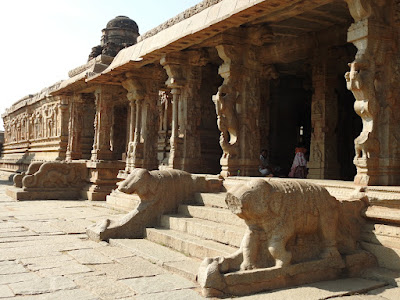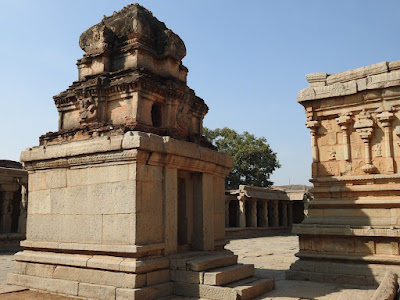...continued from a trip with brother, Hampi-3.
The post lunch plan of the day was to see places without walking around much. So we had picked Sri Krishna Devalaya, one of the larger temple complexes of Hampae, and Krishna Bazaar. Let me quickly list out the larger temple complexes of Hampae here: 1. Virupaksha Devastana, 2. Sri Krishna Devastana, 3. Achyuthraya Swamy Devastana, 4. Vittala Devastana, 5. Hazara Rama Devastana, 6. Pattabhirama Devastana, 7. Malyavatha Raghunatha Devastana and 8. Anantashayana Gudi. All these complexes, including Sri Krishna Devastana, have a large main temple, subsidiary temples, Kalyana Manatapa, kitchen & well, and some of them have colonnades. Of these eight temple complexes, two of them have market spaces associated to them i.e. #1, #2 and #3. The other point is only #1 and #7 are active temples, rest are inactive i.e. no rituals take place since there are no deities.
In the previous post I'd covered the main Gopura and just started looking at the northern Gopura, a smaller structure compared but better preserved. The structure is decorated richly with stucco art of floral patterns and Kirtimukhas. This winged creature made this picture interesting, it gives a sense of scale of the artwork.
In Chalukyan and Hoysala temples, one can see Kirtmukha images in stone but temples built during Vijayanagara sport stucco art. Image the same image in stone. Each has it's pros and cons, each needed artists trained appropriately.
Turning our attention to the temple's large pillared hall which is called as Mahamantapa. The hall consists of approximately 64 pillars i.e. a 8x8 matrix. A Marathi speaking group were resting in the hall. Yeah, everyone needed a break from sunlight.
Two diagonal views of the hall from the front. It was a tricky thing to photograph this temple with light blazing into the lens. The right time to visit most temples is mornings, between 8 AM and 10-30 AM. That's when rays light up the interiors nicely.
Every pillar is unique in terms of the images it has. Each pillar has at least 12 images. The image could be a human form, animal, bird, plant, imaginary creature or geometric pattern. The pillars on the outer lines are complex compared to the inner ones.
View of the outer two rows.
The hall has three entrances; east, north and south. The side entrances have balustrades. Originally these ruined elephant sculptures had trunks stretched out implying a gesture of welcoming.
After the Mahamantapa is the closed hall called as Sabhamantapa or Rangamantapa. The closed hall has two side entrances with balustraded steps. Here, the balustrade features an imaginary creature called Yali. Further into the temple comes the Anthrala (vestibule) and then the Garbhagriha (sanctum). There's a pradakshinapatha (circumambulatory passage) around the Garbhagriha.
Opposite the steps is the southern gateway of the complex which is kept locked. Tourists can enter only from the eastern entrance. Surely there was a Gopura like the one seen on the northern gateway, however only a fraction of the structure remains now.
We move to the rear of the complex. Here's a tiny structure with a three tier Shikhara. Though a subsidiary shrine, the quality of construction is same from bottom to top.
Diagonal view from the southwestern corner. The main temple's dimension in plan is approximately 42m x 14m i.e. it's footprint is abut 590 sqm. Imagine the manpower to built it, leave alone the manpower requirement of the entire complex. Only a super wealthy kingdom could indulge in such lavish buildings. And, Vijayanagara had hundreds of complexes built during it's time. Now imagine the amount of effort gone into temple constructions of all the kingdoms and empires put together.. Ganga, Kadamba, Chalukya, Kakatiya, Hoysala, Kalachuri, Chola, Pandya, and many many more. I guess construction industry supported the economy in a huge way by providing employment to thousands of people.
Now, this is an interesting view. Three Shikharas in one frame. The right and middle are tiny structures and the on the left is the Shikhara of the main temple. Unlike Chalukyan and Hoysala temples, Vijayanagara temples have plain outer walls barring obligatory decor.
Among the subsidiary shrines, this is the largest which is dedicated to Amman. Note the Shikhara design is different.
The Amman temple seems like a Dwikutachala since it has two sanctums. The second sanctum seems like a add on. On the left is the colonnade along the inner security wall, and the northern gateway. The Gopura of the gateway seems undamaged when seen from the front of the temple however it has a gaping hole exposing the brickwork inside.
Closer look at the Gopura and its innards.
Such a handsome structure. Wondering if the damage was caused by nature or man.
I could not shoot more pictures of the temple's front because of sun's position. There were a few more interesting things to see like an inscription slab and another subsidiary shrine. I'll make another visit here in the future and make sure it's in the morning. Coming back to the southern side, that wall and gateway is part of the outer perimeter of this complex. To my right, out of sight is a structure which could be the granary.
This plain walled stone-mortar structure with two openings on its sides must be the granary.
At the side and rear is a staircase. Deepak climbed the narrow stairs sideways, leaning on the wall. Guess he was trying to avoid stepping on the edges in case they chipped away. I can't remember if he said there were openings at the top. Usually granaries have narrow openings at the top.
Done with the tour of the temple tour we headed out but not before taking a shot at this wall of fish. If you notice carefully, there's an inscription on the block above the fish. Surprisingly, the script isn't Kannada or Telugu, it seems like Devanagari script.
It was still 3-30 and our next and last destination of the day- Malyavanta Raghunatha Devastana. The temple is situated on a hillock and a popular sunset point. We wanted to end the day peacefully..
This story will continue in a trip with brother, Hampi-5.
.........































No comments:
Post a Comment